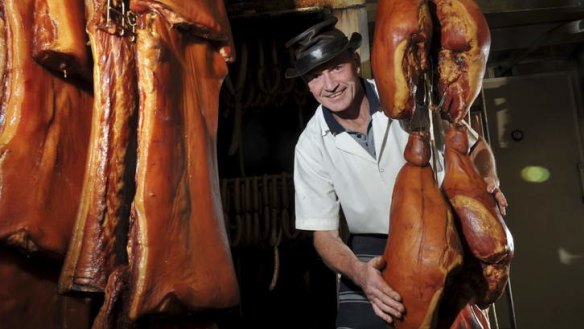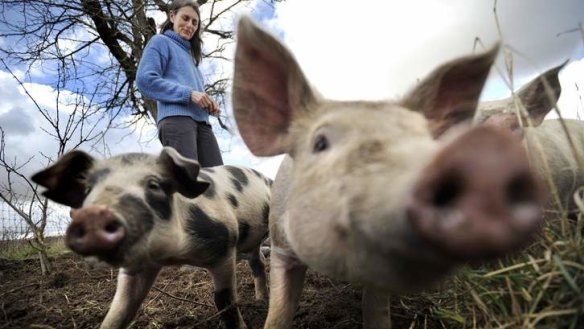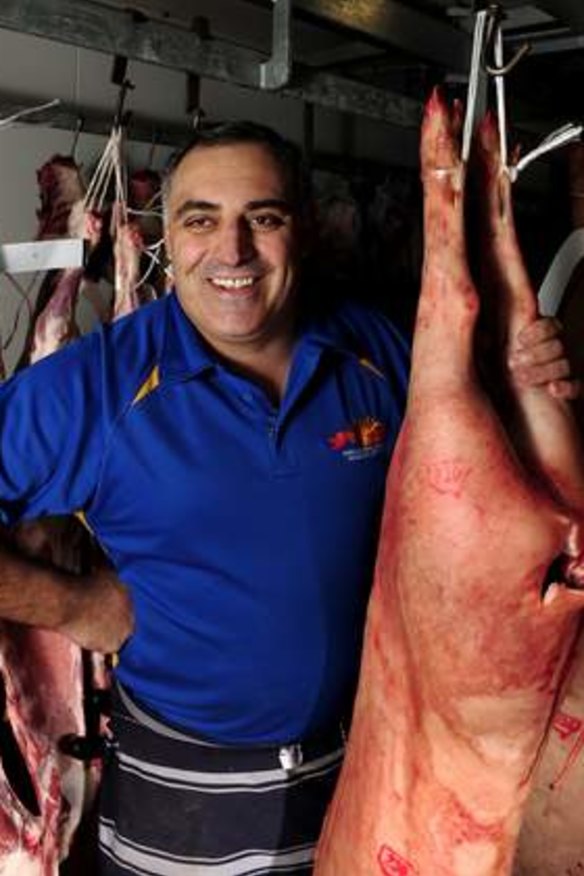Free-range ham not an easy ask
When ordering the ham, do you know what you're getting? <b>Hamish Boland-Rudder</b> talks to Canberra growers about the confusion of free range.

Many of us have no idea where the Christmas ham, that great centrepiece of many a holiday table, comes from. Come Christmas Day, we turn up at the celebratory home, carting presents, something to drink and a salad, and the ham, in all its glory, glazed or unglazed, warm or cool, carving knife by its side, just appears.
But for the nominated hosts, the keepers of the festive spread, sourcing a good ham is no easy task. And for Canberra's butchers, sourcing a consistent supply of local, free-range, quality pork substantial enough to sustain the insatiable Christmas crowds can be near impossible.
Richard Odell, who runs the Griffith Butchery and sources his meat direct from farmers, says people are after ham that is ethically raised and Australian. "I think more and more people are wanting to know where their food is from. They want to know the province or the origin, call it what you will, but people want to know how it's made and be confident with it," he says.

But pay close attention to the label. Odell and other local butchers warn against buying cheaper imported pork, which he says could be pumped with grain-based fillers to increase the weight of the ham, or farmed under lower standards than Australian pork.
But it goes further than local v imported. There are subtle messages on every label, and layers of meaning behind descriptions of the pork.
While Odell's Christmas hams are Australian and handmade in his shop with no gluten or additives beyond some brine and more than 18 hours of woodsmoke, his "free-range" pork is what's known as "born and bred free range". Which doesn't mean the pigs have lived their lives as free-range animals.
I think more and more people are wanting to know where their food is from. They want to know the province or the origin.
Odell gets his pork from Bundawarrah
at Temora, where farmer Stephen Roberts runs about 135 sows and has been in the pig industry for about 20 years. He is upfront about the term ''born and bred free-range''.
Sows have their litters out in the paddock, where the piglets are free to roam for the first three weeks of their lives. Then they are weaned and moved into "eco-shelters" - large sheds lined thick with straw, where the growing pigs are free to move about indoors away from the elements until they're ready for slaughter after a life of about four months.

Roberts says his goal is the consistent, high-quality meat that comes from happy, healthy pigs, but in large enough quantities to still be commercially viable.
"It doesn't matter whether it's moisture-infused, organic, free-range, outdoor bred - if you've got a product that doesn't present and doesn't taste any good, you're not doing the customer any service really, in the long run, and the customer won't come back. We know that our product is consistently a good-quality eating pork," he says.
According to Roberts, controversy over the "free range" label really took off about five or six years ago, when it became "trendy" and large companies recognised the value and tried to use the terminology to cover all manners of farming.
"They wanted the idea of free range to be watered down to suit their needs," he says. Since then a spectrum has been established, from organic to free range to born and bred free range, to provide some clarity to consumers he says.
Belconnen butcher Gino D'Ambrosio from Eco Meats uses a mix of organic pork, which he gets in every four to six weeks from a farmer in Cootamundra (and which is fully free range), and born and bred free range, which comes in almost weekly from a farmer in Victoria.
He plans to sell about 120 Christmas hams this year, about a third of which will be the smaller organic legs that he says are slightly different to the born and bred free range.
"They're as good as each other, they're as lean as each other. The texture's much better in the organic one. They [the organic pigs] are all free range and they're all fed organic grains and feed as well, so there is a little bit in the texture and the taste of them as well," D'Ambrosio says.
"I prefer to use organic all the time, but unfortunately, the supply and demand isn't there. I want more than they can supply, I could use a lot more than they could supply."
Farmer Sam Johnson from Boxgum Grazing, near Young, knows how hard it can be to turn out a constant supply of pasturised free-range pork. He runs about 20 sows as part of his small pork operation, which means at any given time there are about 150 pigs of various ages being moved around their farm - nowhere near enough to supply the hungry masses Canberra's butchers expect to feed over Christmas. Instead, Johnson, with his wife, Claire Johnson, sells direct to consumers either through direct order or at Canberra's two farmers' markets each weekend.
"As a small-scale grower, we can't compete on price in that market with the large growers. Our niche is really direct selling to the customer," he says.
"The big growers are getting bigger and the small growers just find it hard to compete."
Johnson says bigger "free-range" operations usually need to make some concessions in order to produce enough meat - which means an intensification of their farming practices. But Johnson's customers tend to be savvier when it comes to finding out where their food comes from.
"There are people who want to know how the animal has been grown," he says. "There's a perception about free range, so a lot of the other larger producers have tried to jump across on to it as a marketing ploy. So people are wary of claims and want to know how they're backed up.''
Another farmer, Tobias Koenig, who runs neighbouring properties Mulloon Creek and Ingelara near Bungendore, says despite a growing interest in eating organic, it would be difficult if not impossible to run a genuinely free-range operation at the scale needed for consistent supply at a reasonable price.
"You have to realise it is substantially more expensive than non-free range ham," he says. "It is difficult to make substantial income from it because if you go to one of these intense piggeries, they run hundreds of pigs, while if you do it outdoors it's very difficult. You have to manage them very carefully, because if you don't they dig up all the pastures."
Between the two farms, Koenig has about 10 sows, and all their free-range pigs (fully free range, not simply ''born and bred'') go straight to either Canberra chef Janet Jeffs from Ginger Catering at the National Arboretum, or to private buyers.
"I think it is three things. One is the taste, the other one is customers who are aware that we have to be more sustainable, and customers who think it is important that we support local farmers … ethics is important for some people."
Newcomer Pialligo Farm uses Mulloon Creek pork for its traditionally cured and smoked hams (we have a story on this operation in December).
But butcher Darryl Weekes from Garran-teed Meats in Garran isn't so sure that ethics are a big factor, when it comes to fronting up cash for the centrepiece of the yuletide feast.
Weekes stocks a mix of pasturised free-range pork (pigs that spent their whole life ranging free) and born and bred free range pork from a range of Australian suppliers, and this year hopes to sell about 350 Christmas hams - about 60 of them pasturised free range.
Compared with imported or intensively farmed pork, free-range is a more expensive product - Weekes says organic, ''pasturised'' free range (kept on pasture) is almost prohibitively expensive - but people don't mind paying more for it: not because it's more humane, ethical, or even sustainable but, because, ultimately, it's a better-quality meat.
"They're buying it because it tastes better. It's a better product all together. The problem with buying it because it's Australian or buying it because it's free range - the problem with people buying it for that reason is that there is a week there they don't have money, the car breaks down, something happens, well, they go and buy the [cheaper] product. That's it. But [ours is] a better product, therefore they keep coming back," he says.
At Griffith, Odell agrees that in the end it's all about the meat. When it comes to Christmas he will take home one of his big hams, which he makes to his liking - lightly flavoured with salt and woodsmoke.
"What are [customers] after? An experience, a good experience, because purchasing meat's not just going out and buying it," he says. "They're after the ability to impress."
And that means not only serving good meat, but also knowing exactly where that ham hails from.
>> Hamish Boland-Rudder is a staff reporter.
Restaurant reviews, news and the hottest openings served to your inbox.
Sign up